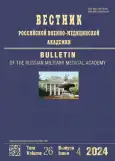Potential use of xenogenic biomaterial based on elastin derived from animal aortas for tissue remodeling
- Authors: Shutskiy N.A.1,2, Kashutin S.L.1, Gorbatova L.N.1, Kholopov N.S.1, Mizgirev D.V.1, Sherstennikova A.K.1, Sherstennikov N.V.1, Shagrov L.L.1
-
Affiliations:
- Northern State Medical University
- Northern (Arctic) Federal University named after M.V. Lomonosov
- Issue: Vol 26, No 4 (2024)
- Pages: 533-540
- Section: Original Study Article
- Submitted: 20.02.2024
- Accepted: 01.10.2024
- Published: 20.12.2024
- URL: https://journals.eco-vector.com/1682-7392/article/view/627216
- DOI: https://doi.org/10.17816/brmma627216
- ID: 627216
Cite item
Abstract
This study addresses one of the key challenges in experimental and regenerative medicine: the development of a novel biomaterial based on native elastin, devoid of antigenic properties and derived from the aorta of a reindeer, by complete decellularization, with the aim of using it for tissue remodeling after injuries. The development of new approaches and agents for treating thermal burns and wounds (including gunshot wounds) is a crucial task, especially given the current context of large-scale military operations. The concept of obtaining a bioresorbable material with reduced antigenic properties from reindeer connective tissue arises from the need to improve treatment methods aimed at accelerating reparative processes in thermal and gunshot injuries, including penetrating wounds, as well as in those with a high risk of complications and permanent disability. Elastin, a fibrillar protein responsible for tissue stretching, is a key component of connective tissue found in many organs. In this study, the aorta of a reindeer, an elastic-type artery, was chosen as the source of elastin. Through mechanical, chemical, and biochemical processing, cells, collagen fibers, and ground substance with antigenic properties were removed, and an elastin-based biomaterial was obtained. The biomaterial was analyzed using light and electron microscopy. It was then used as a xenograft without antigenic properties to restore tissue integrity after thermal injuries. In experiments on laboratory rats, no rejection reactions were observed, indicating the absence of immunogenicity in the obtained biomaterial. These results suggest the potential use of this aorta-derived biomaterial for tissue remodeling to accelerate healing processes.
Full Text
About the authors
Nikita A. Shutskiy
Northern State Medical University; Northern (Arctic) Federal University named after M.V. Lomonosov
Author for correspondence.
Email: nikitashutskijj@rambler.ru
ORCID iD: 0000-0003-0979-1569
SPIN-code: 1430-4970
Cand. Sci. (Biology)
Russian Federation, Arkhangelsk; ArkhangelskSergey L. Kashutin
Northern State Medical University
Email: sergeycash@yandex.ru
ORCID iD: 0000-0002-2687-3059
SPIN-code: 7623-7216
MD, Dr. Sci. (Medicine), associate professor
Russian Federation, ArkhangelskLyubov N. Gorbatova
Northern State Medical University
Email: info@nsmu.ru
ORCID iD: 0000-0003-0675-3647
SPIN-code: 8037-5341
MD, Dr. Sci. (Medicine), professor
Russian Federation, ArkhangelskNikita S. Kholopov
Northern State Medical University
Email: nikitaholopov@mail.ru
ORCID iD: 0000-0001-5604-5257
SPIN-code: 6776-4068
postgraduate
Russian Federation, ArkhangelskD. V. Mizgirev
Northern State Medical University
Email: denimsur@rambler.ru
ORCID iD: 0000-0002-6804-3790
SPIN-code: 6202-6807
MD, Dr. Sci. (Medicine), associate professor
Russian Federation, ArkhangelskA. K. Sherstennikova
Northern State Medical University
Email: a.sherstennikova@yandex.ru
ORCID iD: 0000-0001-8576-6459
SPIN-code: 7473-3278
MD, Dr. Sci. (Medicine), associate professor
Russian Federation, ArkhangelskNikolay V. Sherstennikov
Northern State Medical University
Email: shersten96@gmail.com
ORCID iD: 0009-0004-1606-3775
SPIN-code: 2684-8233
junior research assistant
Russian Federation, ArkhangelskLeonid L. Shagrov
Northern State Medical University
Email: leonidshagrov@mail.ru
ORCID iD: 0000-0003-2655-9649
SPIN-code: 3842-2145
junior research associate
Russian Federation, ArkhangelskReferences
- Kraft R, Herndon DN, Finnerty CC, et al. Predictive value of IL-8 for sepsis and severe infections after burn injury-A clinical study. Shock. 2015;43(3):222. doi: 10.1097/SHK.0000000000000294
- Peretyagin PV, Solovyova AG, Boyarinov GA, Martynov IA. Features of the functional state of pro- and antioxidant balance, enzymatic activity and substrate energy supply in the treatment of burn shock with ozonated saline solution, mexidol and microhydrin in an experiment. Bioradicals and Antioxidants. 2020;7(3):205–214. (In Russ.) EDN: VLAMYW
- Friedman LS, Abasilim C, Fitts R, Wueste M. Clinical outcomes of temperature related injuries treated in the hospital setting, 2011–2018. Environ Res. 2020;189:109882. doi: 10.1016/j.envres.2020.109882
- Merrell SW, Saffle JR, Sullivan JJ, et al. Increased survival after major thermal injury: a nine year review. Am J Surg. 1987;154(6): 623–627. doi: 10.1016/0002-9610(87)90229-7
- Kovalev AN, Kovalev NN, Pivnenko TN. Collagen of some species of fish and invertebrates. In: Current problems of development of biological resources of the World Ocean. 2020:45–48. EDN: IRFRBT
- Vorobyov VI, Nizhnikova EV. Obtaining collagen and hydroxyapatitis fractions from fish scales. KSTU News. 2021;62: 80–91. EDN: NQXDTM doi: 10.46845/1997-3071-2021-62-80-91
- Antipova LV, Storublevtsev SA, Bolgova SB. As the use of collagen substances fish origin for tissue wound healing. Bulletin of Voronezh State University. Series: Chemistry. Biology. Pharmacy. 2016;(4):123–126. EDN: XGRHBZ
- Antipova LV, Glotova IA. Obtaining collagen substances based on enzymatic processing of secondary raw materials of the meat industry. News of higher educational institutions. Food technology. 2000;5–6:17–21. (In Russ.) EDN: QCPFOR
- Abdullaeva MA, Urakova KH. Histological characteristics of the aortic wall. Education, science and innovative ideas in the world. 2023:33(1):48–55. (In Russ.)
- Patent RUS No. 2689337/ 21.12.2022. Kholopov NS, Gorbatova LN, Kashutin SL, et al. Method for obtaining xenogenic biomaterial from reindeer aorta. (In Russ.)
- Barker K. Phenol-Chloroform Isoamyl Alcohol (PCI) DNA Extraction. In: At the bench: a laboratory navigator. 1998. P. 284–289.
- Allaire E, Guettier C, Bruneval P, et al. Cell-free arterial grafts: morphologic characteristics of aortic isografts, allografts, and xenografts in rats. J Vasc Surg. 1994;19(3):446–456. doi: 10.1016/S0741-5214 (94)70071-0
- Tsarev SV. Fungal allergy in clinical practice. Russian Journal of Allergy. 2010;(4):11–31. EDN: MWGMGB
Supplementary files
















